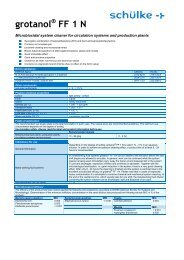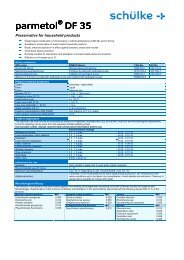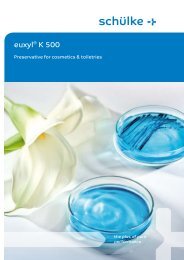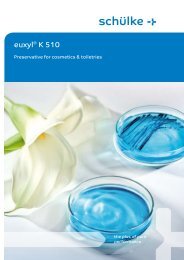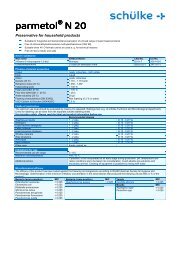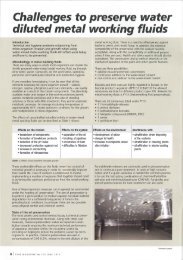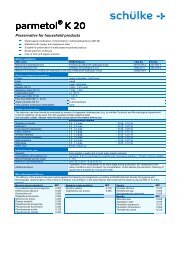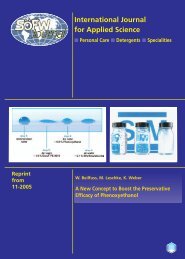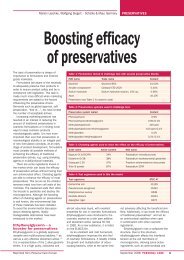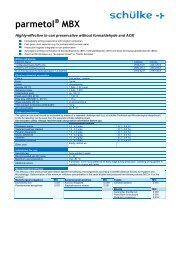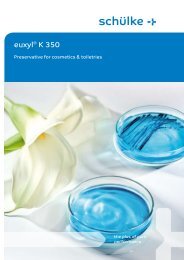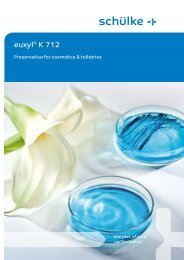International Journal for Applied Science - ResearchGate
International Journal for Applied Science - ResearchGate
International Journal for Applied Science - ResearchGate
Create successful ePaper yourself
Turn your PDF publications into a flip-book with our unique Google optimized e-Paper software.
<strong>International</strong> <strong>Journal</strong><strong>for</strong> <strong>Applied</strong> <strong>Science</strong>■ Personal Care ■ Detergents ■Specialties25g of each material to be testedS&M Koko testperiodic microbiological preservation test6 weeks = 6 inoculation cyclesweekly inoculation with 0.1 ml mixedsuspension (titre 10 8-9 cfu/ml)0.1 mlwithoutpreservativewith x %preservativestorage at +25°CGerm spectrumBacteria:grampositiveKocuria rhizophilaStaphylococcus aureusgramnegativeEnterobacter gergoviaeEscherichia coliKlebsiella pneumoniaePseudomonas aeruginosaPseudomonas fluorescensPseudomonas putidaMoulds:Aspergillus nigerPenicillium funiculosumYeasts:Candida albicansmicroorganisms used inpharmaceutical testsStreak weekly be<strong>for</strong>e each inoculation ontryptone-soya-agar sabouraud-dextrose-agaragar platesAssessment:- free of growth+ slight growth++ moderate growth+++ heavy growthselective identification ofbacteria, yeasts and mouldsIncubation of thenutrient media:3 days at + 25°CReprintfrom12-2006W. Siegert:The Benefit of Using Synergistic Mixturesof Preservatives
COSMETICSPRESERVATIVESW. Siegert*The Benefit of Using Synergistic Mixturesof PreservativesKeywords: Preservation, organic acids, cosmeticsThe patents DE 4026756 (1)and US 5670160 (2) describethe synergistic mixture of differentorganic acids in combinationwith different alcohols andpoly(hexamethylene biguanide)salts. This paper scrutinizes theadvantage of a commerciallyavailable mixture using this combination<strong>for</strong> the preservation ofcosmetics and toiletries. Theamount of polyaminopropylbiguanide in this <strong>for</strong>mulated productis far below its normally recommendeduse concentration, it actstogether with the Ethylhexylglycerinas a preservative enhancer. IntroductionSummaryThe efficacy of a simple acid/alcohol mixture(Product A) with following composition:Product A% w/wPhenoxyethanol 74Benzoic Acid 12Dehydroacetic Acid 7Aqua 7was compared with Product B (Euxyl® K702) using the synergistic effect describedin the above mentioned patents withfollowing composition:Product B% w/wPhenoxyethanol 74Benzoic Acid 12Dehydroacetic Acid 7Aqua 4Ethylhexylglycerin 2Polyaminopropyl Biguanide 1The testing was per<strong>for</strong>med using a serialdilution test to compare the minimalinhibition concentrations (MIC values), agerm count reduction test to comparethe biocidal effect and also a repeatedchallenge test to evaluate the efficacy aspreservative under practical conditions. MIC valuesTable 1 MIC values of product A compared with product BDetermination of the minimum inhibitoryconcentration in serial dilution testsproduced values at pH 5.5, shown inTable 1.Product B is at least twice as effective asproduct A, an inhibition of the test germsis possible with a far lower amount of activeingredients.Product AProduct BSpecies ATCC N° MIC value [%]Gram-negative:Burkholderia cepacia 17759 0.50 0.25Enterobacter gergoviae 33028 0.75 0.06Escherichia coli 11229 0.25 0.06Klebsiella pneumoniae 4352 0.50 0.12Pseudomonas aeruginosa 15442 0.50 0.25Pseudomonas fluorescens 17397 0.25 0.06Pseudomonas putida 12633 0.50 0.12Gram-positive:Staphylococcus aureus 6538 0.50 0.12Staphylococcus epidermidis 12228 0.50 0.06Mould fungi:Aspergillus niger 6275 0.25 0.12Penicillium funiculosum 36839 0.25 0.12Yeasts:Candida albicans 10231 0.25 0.1248 SÖFW-<strong>Journal</strong> | 132 | 12-2006
COSMETICSPRESERVATIVESFig. 1 Microorganism reduction achieved <strong>for</strong> product B in comparison to product A at pH 5.550 SÖFW-<strong>Journal</strong> | 132 | 12-2006
COSMETICSPRESERVATIVES Germ count reduction testDilutions of product A and Product B areprepared with sterile tap water and adjustedwith sodium hydroxide to pH 5.5.50 ml portions of the end solutions areinoculated with 0.5 ml microorganismsuspension (initial microorganism countapprox. 10 8 cfu/ml) and stirred (Table 2).Test organisms ATCC N°Pseudomonas aeruginosa 15442Escherichia coli 11229Candida albicans 10231Aspergillus niger 6275Table 2 Test organisms <strong>for</strong> the germcount reduction testThe solutions are streaked out onto tryptonesoya agar or sabouraud-dextrose4% agar after 3, 6, 24, 48, 72 and 168hours, depending on the test organism.The cultures are incubated <strong>for</strong> 48 hoursat 37 °C, except in the case of Aspergillusniger, which is incubated <strong>for</strong> 72 hours at25 – 27 °C. The evaluation is made on thebasis of a semi-quantitative assessmentof the microbial growth of the streaks.Fig. 1 shows the microorganism reductionachieved <strong>for</strong> product B in comparisonto product A at pH 5.5 as a functionof the contact time and use-concentrationis presented <strong>for</strong> the various test organisms.Product B has a more efficient germ reduction,as evidenced by the greater killrate at earlier time readings. This is especiallyuseful <strong>for</strong> pre-contaminated rawmaterials, such as the production wateror the non-woven, as they may be moreeasily sanitised with product B. Repeated Challenge TestFor the test we used a w/o lotion accordingto Formulation 1.In this <strong>for</strong>mulation we incorporated indifferent batches 0.2, 0.4 and 0.6% ofproduct A in comparison to product Band ran a repeated challenge test accordingto the S&M Koko test protocol.In this test, a mixture of bacteria, yeastand moulds are inoculated 6 times (onceTrade name INCI Name % w/wPhase A Aqua 73.0a week) into the test material (Fig. 2),with the goal of keeping the test materialgerm free throughout this period.The inoculum contains pathogenic microorganismssuch as germs that are wellknown <strong>for</strong> product spoilage. All specieshave to be cultivated separately andmixed directly be<strong>for</strong>e the addition, toensure a constant composition and germcount of the inoculum. Its germ count isapproximately 10 8-9 cfu/ml, which meansa germ count of approximately 10 6 cfu/Propylene Glycol 5.0Phase B Dehymuls HRE 7 PEG-7 Hydrogenated Castor Oil 3.0Lamepon TGI Polyglyceryl-3 Diisostearate 1.0Cetiol A Hexyl Laurate 5.0Cetiol SN Cetearyl Isononanoate 7.0Cetiol OE Cetearyl Isononanoate 6.0Formulation 1 Lotion w/o Test Formula (unpreserved)25g of each material to be testedwithoutpreservativeGerm spectrumBacteria:grampositiveKocuria rhizophilaStaphylococcus aureusgramnegativeEnterobacter gergoviaeEscherichia coliKlebsiella pneumoniaePseudomonas aeruginosaPseudomonas fluorescensPseudomonas putidawith x %preservativeMoulds:Aspergillus nigerPenicillium funiculosumYeasts:Candida albicansmicroorganisms used inpharmaceutical testsFig. 2 Repeated challenge testS&M Koko testml in the sample. A sample can be calledwell preserved, if it passes a period of sixweeks under the above described laboratoryconditions without showing microbialgrowth on the test batches. Thatmeans even after the sixth inoculationno microbial growth can be observed.From many years experience in the useof this test method these results canstate the microbiological stability of 30months which is recommended <strong>for</strong> cosmeticproducts.periodic microbiological preservation test6 weeks = 6 inoculation cyclesweekly inoculation with 0.1 ml mixedsuspension (titre 10 8-9 cfu/ml)0.1 mlstorage at +25°CStreak weekly be<strong>for</strong>e each inoculation ontryptone-soya-agar sabouraud-dextrose-agaragar platesAssessment:- free of growth+ slight growth++ moderate growth+++ heavy growthselective identification ofbacteria, yeasts and mouldsIncubation of thenutrient media:3 days at + 25°CSÖFW-<strong>Journal</strong> | 132 | 12-2006 51
COSMETICSPRESERVATIVESTest material/ProductInoculation CyclespH 0 1 2 3 4 5 6Lotion-O/W, unpreserved+ 0.2% Product A+ 0.4% Product A5.5 +++ +++ +++ ./.B BMY BMY5.5 - +++ +++M M ./.5.5 - ++ ++ +++ +++M M M M ./.+ 0.6% Product A 5.5 - - - - - - -+ 0.2% Product B 5.5 - - - - - - -+ 0.4% Product B 5.5 - - - - - - -+ 0.6% Product B 5.5 - - - - - - -Legend: 0 = Sterility control - = free of microbial growthB = Bacteria + = slight growthM = Moulds ++ = moderate growthY = Yeasts +++ = massive growthTable 3 Results from the repeated challenge testThe challenge test was passed with 0.2%product B. Product A needs to be addedat a 0.6% use concentration. The detailedresults are summarised in Table 3.Literature(1) DE 4026756: Preservative <strong>for</strong> use in cosmetics, pharmaceuticals and cleaning products -contains organic acid, benzyl or phenoxy-alkyl alcohol and poly-hexamethylene biguanide salt(2) US 5670160: Preservatives and their use ConclusionThe use of synergistic preparations <strong>for</strong>the preservation of cosmetics and toiletriescan reduce the necessary amountof preservative actives and enhance thespeed of biocidal efficacy.* Authors’ address:Wolfgang SiegertApplication DepartmentSchülke & Mayr GmbHSpecial Additive <strong>International</strong>22840 NorderstedtGermanyMailto: sai@schuelke-mayr.com52 SÖFW-<strong>Journal</strong> | 132 | 12-2006




